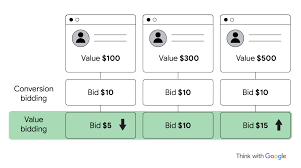In the fast-paced world of online advertising, every click counts. But are you getting the most out of your ad spend? Traditional bidding strategies like cost-per-click (CPC) focus on clicks, not necessarily conversions or customer value. This is where value-based bidding enters the game, offering greater control and ROI for advertisers.
What is Value-Based Bidding and How Does it Work?
Value-based bidding is a paid advertising strategy that goes beyond simply getting clicks. It allows you to set bids based on the predicted value of a conversion, rather than just the cost of the click itself.

Image source: Think With Google – https://www.thinkwithgoogle.com/intl/en-emea/marketing-strategies/automation/bidding-for-value-automation/
While conversion-based bidding empowers you to prioritise valuable impressions or conversions, value-based bidding takes it a step further.
It allows you to leverage your business insights and AI technology to create highly customised bidding strategies tailored to your specific goals.
Here’s how custom bidding works:
- Define Your Goals: Choose from creating custom bidding goals using weighted conversions or writing custom bidding scripts (see this example for Google Display and Video 360). This lets you optimise bids based on factors beyond just conversions, such as brand awareness metrics or specific product categories.
- Granular Control: Assign weights to impressions based on their relevance to your goals. This allows you to prioritise impressions with a higher likelihood of driving valuable conversions. An example that XPON has delivered for our clients via Google’s Display and Video 360, is increasing bidding on video impressions with increased brand exposure such as video views played with audio or those viewed longer than 3 seconds.
- Data-Driven Learning: Your custom bidding algorithm goes through a training phase using machine learning. It analyses your past campaign data to understand your goals and preferences, continuously improving its ability to identify and prioritise the most valuable impressions for your campaigns.
The Benefits for Marketers:
- Granular Control & Flexibility: Custom bidding offers a level of control and flexibility not available with standard bidding strategies.
- Increased Efficiency & Optimised Budgets: By focusing on valuable conversions, value-based bidding eliminates wasted clicks and optimises your advertising budget. That means over time you spend less on clicks that won’t convert and more on clicks that drive high-value customer engagement.
- Driving Conversions with Higher Customer Lifetime Value: Value-based bidding can help you attract customers with a higher potential lifetime value. This means focusing on acquiring customers who are likely to not only convert but also become loyal, repeat customers.
- Gaining Deeper Customer Insights for Informed Decision-Making: Value-based bidding relies on customer data and conversion tracking. This data can provide valuable insights into your customer base and their behaviour, allowing you to make informed decisions about your overall marketing strategy.
Implementing Value-Based Bidding for Campaign Optimisation
Choosing the Right Value-Based Bidding Strategy:
There are two main strategies available:
- Maximising Conversion Value: This strategy prioritises conversions with the highest predicted value. This is ideal for campaigns where you want to focus on high-value actions like product purchases or service subscriptions.
- Target Return On Ad Spend (ROAS): This strategy allows you to set a specific target return on ad spend (ROAS) percentage. The algorithm then adjusts bids to achieve your desired ROAS, ensuring you get the most value out of your advertising budget.
Essential Data for Effective Value-Based Bidding Campaigns:
To leverage value-based bidding effectively within advertising platforms such as Google Display and Video 360, you’ll need access to key data:
- Historical Conversion Data & Customer Lifetime Value: Historical data on past conversions and customer value helps the bidding algorithm predict the value of future conversions.
- Audience Segmentation & Targeting Strategies: Segmenting your audience allows you to tailor your bids and messaging to different groups with varying conversion values.
To give you a feel for the data sources that can fuel value-based bidding, within the Google ecosystem specifically, you can use signals from:
- Floodlight events and custom Floodlight variables
- Google Analytics goals
- Impression signals
In our experience, we find clients continue to bid on volume as opposed to the value of conversion as revenue, lifetime value, lead value or profitability as this data isn’t always available within ad platforms. As a first step at least one of these data points should be accessible or available with little or no ongoing effort for a seamless adoption of automated bidding towards value. XPON customers using our Wondaris(R) tools with DV360 or SA360 are able to do this even more efficiently.
Ongoing Monitoring & Optimisation for Continuous Improvement
Value-based bidding is an ongoing process.
Regularly monitor campaign performance, analyse data, and adjust strategies to ensure your models are accurately targeting your advertising goals for maximum return.
Conclusion: Bidding Your Way to Success
Value-based bidding is a powerful tool that empowers marketers to move beyond clicks and focus on acquiring high-value customers.
By leveraging data, setting clear goals, and employing the right strategies, you can optimise your ad spend, maximise campaign performance, and achieve sustainable marketing success.
If you’re looking for support or further technical details to implement VBB across your advertising tools, please get in touch with the XPON team here. As full-stack Google Marketing Platform partner, we’ve supported a plethora of brands to implement AI-powered advertising strategies to improve ROAS and ROI.
